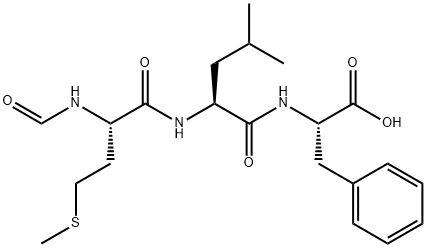All AbMole products are for research use only, cannot be used for human consumption.

N-Formyl-Met-Leu-Phe (fMLP) is a chemotactic peptide and a specific ligand of N-formyl peptide receptor (FPR), which can inhibit TNF-alpha secretion. N-Formyl-Met-Leu-Phe (fMLF) acts as an agonist at formyl peptide receptors (FPR; Ki = 0.8 pM). N-Formyl-Met-Leu-Phe promotes osteoblastic commitment and suppresses adipogenic commitment under osteoblastic differentiation conditions. N-Formyl-Met-Leu-Phe stimulates osteogenesis is associated with increased expression of osteogenic markers and mineralization. N-Formyl-Met-Leu-Phe inhibits expression of peroxisome proliferator-activated receptor-γ1. N-Formyl-Met-Leu-Phe promotes bone formation in zebrafish and rabbits. Treatment with N-Formyl-Met-Leu-Phe results in increased expression of Runx2. Bone marrow spaces are widely formed, and connective tissue covering bone is dense, like periosteum, in N-Formyl-Met-Leu-Phe-treated calvaria.
| Molecular Weight | 437.55 |
| Formula | C21H31N3O5S |
| CAS Number | 59880-97-6 |
| Solubility (25°C) | DMSO ≥ 60 mg/mL |
| Storage | -20°C, sealed |
| Related FPR Products |
|---|
| Ac9-25
Ac9-25, a N-terminal peptide of Annexin I, acts as a formyl peptide receptor (FPR) agonist and activates the neutrophil NADPH oxidase through FPR. |
| N-Formyl-Nle-Leu-Phe-Nle-Tyr-Lys
N-Formyl-Nle-Leu-Phe-Nle-Tyr-Lys TFA (For-Nle-Leu-Phe-Nle-Tyr-Lys-OH TFA) is a formyl peptide receptor (FPR) agonist. |
| WKYMVM-NH2 TFA
WKYMVM-NH2 TFA is a potent N-formyl peptide receptor (FPR1) and FPRL1/2 agonist, also activates several leukocyte effector functions. |
| {Boc}-Phe-Leu-Phe-Leu-Phe
{Boc}-Phe-Leu-Phe-Leu-Phe ({Boc}-FLFLF) is a formyl peptide receptor (FPR) family antagonist that preferentially inhibits activity triggered through the formyl peptide receptor. |
| WKYMVM
WKYMVM is a potent N-formyl peptide receptor (FPR1) and FPRL1/2 agonist, also activates several leukocyte effector functions such as chemotaxis, mobilization of complement receptor-3, and activation of the NADPH oxidase. |
All AbMole products are for research use only, cannot be used for human consumption or veterinary use. We do not provide products or services to individuals. Please comply with the intended use and do not use AbMole products for any other purpose.


Products are for research use only. Not for human use. We do not sell to patients.
© Copyright 2010-2024 AbMole BioScience. All Rights Reserved.
